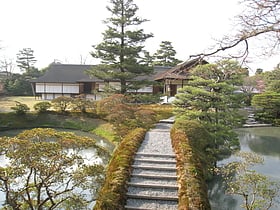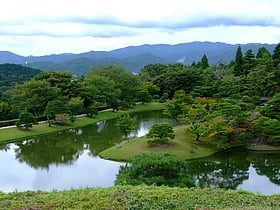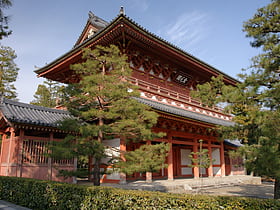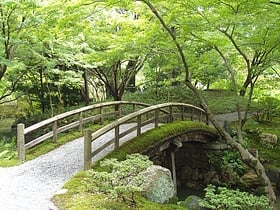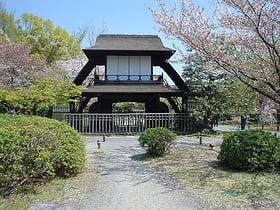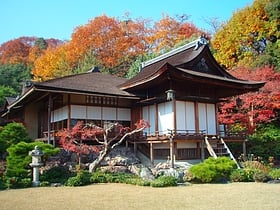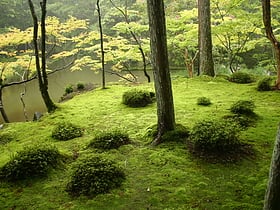Kyoto: Garden
Places and attractions in the Garden category
Categories
- Temple
- Sacred and religious sites
- Buddhist architecture
- Buddhist temple
- Museum
- Historical place
- Park
- Unesco
- Garden
- Art museum
- Specialty museum
- Street
- Universities and schools
- History museum
- Palace
- Area
- Theater
- Concerts and shows
- Shopping
- Bridge
- Neighbourhood
- Sport venue
- Sport
Katsura Imperial Villa
Historic palace with a Japanese garden Nestled in the tranquil city of Kyoto, the Katsura Imperial Villa stands as a pinnacle of traditional Japanese architecture and garden design. This exquisite site, also known as Katsura Rikyu, is a paragon of the Japanese aesthetic, offering visitors a glimpse into the...
Shugakuin Imperial Villa
Nestled in the serene landscapes of Kyoto, Japan, the Shugakuin Imperial Villa is a hidden gem that embodies the tranquil beauty and traditional aesthetics of Japanese garden design. This imperial park, established in the 17th century by Emperor Gomizuno-o, is a...
Daitoku-ji
Buddhist temple site known for gardens Nestled in the northern part of Kyoto, Daitoku-ji stands as a testament to the city's deep-rooted Zen Buddhist traditions. This sprawling temple complex, established in the 14th century, is not only a place of religious significance but also a serene park that offers a...
Sentō Imperial Palace
Picturesque 17th-century palace gardens Sentō Imperial Palace, nestled in the heart of Kyoto, Japan, stands as a serene testament to the city's rich imperial past. This historic site, once a residence for retired emperors, embodies the opulent and refined aesthetics of Japanese court life.
Shosei-en Garden
Shosei-en Garden is a serene oasis nestled in the heart of Kyoto, Japan, offering a tranquil escape from the bustling city life. This historical garden, also known as Kikoku-tei, is a designated cultural asset and has been a cherished part of Kyoto's cultural heritage...
Kyoto Botanical Garden
Botanical gardens with a serene setting The Kyoto Botanical Garden, nestled in the heart of the ancient city of Kyoto, Japan, is a verdant oasis that offers a serene escape from the urban landscape. Established in 1924, this expansive park encompasses an area of roughly 240,000 square meters and is renowned...
Ōkōchi Sansō
Ōkōchi Sansō is the former home and garden of the Japanese jidaigeki actor Denjirō Ōkōchi in Arashiyama, Kyoto. The villa is open to the public for an admission fee and is known for its gardens and views of the Kyoto area. Several of the buildings are recorded as cultural properties by the national government.
Konchi-in Temple
Konchi-in is a Buddhist temple in Sakyō-ku, Kyoto, western Japan. The temple is renowned for its Crane and Turtle Garden Japanese garden.
Shisen-dō
Historic Buddhist temple with gardens Shisen-dō is a Buddhist temple of the Sōtō Zen sect in Sakyō-ku, Kyoto, Japan. It is registered as a historic site of Japan. It stands on the grounds of its founder, the Edo period intellectual Ishikawa Jōzan, who established the temple in 1641.
Taizō-in
Taizō-in is the oldest sub-temple of the Myōshin-ji Rinzai Zen Buddhist temple, situated in the northwest of Kyoto, Japan. It was founded by Zen priest Muinsoin in 1404.
Saihō-ji
Buddhist temple with famed moss garden Saihō-ji is a Rinzai Zen Buddhist temple in Matsuo, Nishikyō Ward, Kyoto, Japan. The temple, which is famed for its moss garden, is commonly referred to as "Koke-dera", meaning "moss temple", while the formal name is "Kōinzan Saihō-ji".
Manshu-in
Manshu-in, also known as the Manshuin Monzeki, is a Tendai temple located near the Shugakuin Imperial Villa at Sakyō-ku, Ichijo-ji, Takenouchi-cho, in northeast Kyoto, Japan. The temple was founded by Dengyō Daishi in the 8th century. It was then located near Mount Hiei and known as Tobibo, but renamed Manshuin in 1108 or 1109.
Ryōgen-in
Ryōgen-in is a subtemple of the Daitoku-ji Buddhist complex, located in Kita-ku, Kyoto, Japan. It was constructed in 1502. There are five gardens adjoining the abbot's residence, including Totekiko, Isshi-dan, Koda-tei, and Ryogin-tei.
Map

